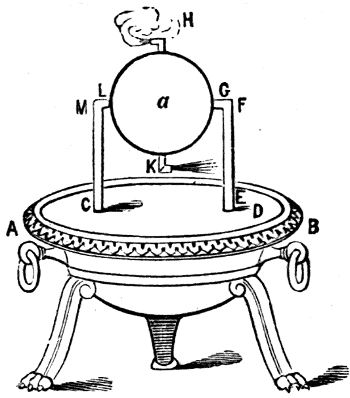|
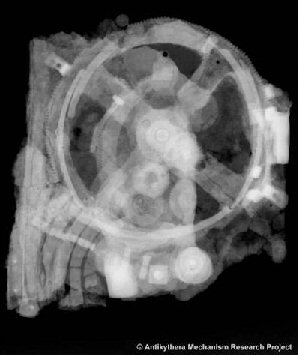
 Greek
Automata:
(Gr: Automatos - 'self-moving') Greek
Automata:
(Gr: Automatos - 'self-moving')
When his writings on hydraulics, pneumatics and
mechanics were translated into Latin in the sixteenth century,
Hero�s readers were amazed to discover descriptions of inventions which
included vending machines, a water-pump, a wind-organ, and the aeolipile
(the first recorded steam engine). Although today the only surviving example
of such sophisticated ancient Greek mechanics is the
Antikythera
mechanism (right), it is clear that complex mechanical devices existed
in ancient Greece.
The following
examples leave no doubt that the ancient Greeks had taken the
first steps towards mechanisation. Whilst it is true that many
of descriptions of automata are for objects of curiosity or
whimsy, the Antykithera mechanism, Dioptra and Odometer are
scientific instruments, demonstrating that their discoveries had
also begun to be utilised in a functional capacity, such that
one is left to wonder what the path of a mechanised Greek empire
would have been given the chance to continue.
|
Automatons in Greek Mythology: |
The Automatons of Hephaestus
:
The Greek God
Hephaestus was the god of Metallurgy amongst other things. Greek
mythology says that he was supposed to have built automatons to work for him in
a workshop. He was said to have
made metallic statues of
animal, men and monsters crafted and made animate by the divine
smith Hephaistos.
Talos: Perhaps his most well-known
mechanical man was a bronze giant named Talos. In the story Argonautica, Talos guards the island of Crete by tossing
boulders at any unfriendly ships that approach. The legend has it
that Talos had a vein that ran through his body filled with a
blood-like fluid and sealed with a nail. When the nail was removed,
the fluid ran out and Talos was destroyed.
The Golden
Tripods of Olympus:
"[Hephaistos] was sweating as he turned here and there to his
bellows busily, since he was working on twenty tripods which were to
stand against the wall of his strong-founded dwelling. And he had
set golden wheels underneath the base of each one so that of their
own motion they could wheel into the immortal gathering, and return
to his house: a wonder to look at. These were so far finished, but
the elaborate ear handles were not yet on. He was forging these, and
beating the chains out."
(Homer, Iliad 18. 371 ff - Trans. Lattimore)
The Hippoi
Kabeirikoi: These were four
horse-shaped
automotones
crafted by the god Hephaistos out of bronze to draw the adamantine
chariot of his two sons, the
Kabeiroi.
"[The Kabeiroi] rode in a car of adamant; a pair of colts beat the
dust with rattling hooves of brass, and they sent out a dry
whinnying from their throats. These father Hephaistos had made with
his inimitable art, breathing defiant fire between their teeth, like
the pair of brazenfooted bulls which he made for Aietes the
redoubtable ruler of the Kolkhians, with hot collars and burning
pole. Eurymedon [one of the Kabeiroi] drove and guided the fiery
mouths of the ironfoot steeds with a fiery bridle."
(Nonnus, Dionysiaca 29. 193 ff - Trans. Rouse)
The tales of Hephaistos are clearly mythical, but there is
good reason to believe that the Greeks themselves were adept at creating automata
figures, as the following accounts indicate:
|
Ancient
Greek Automatons: |
Records of Greek Automata:
The early Greek experiments with automata are
believed to have been produced as 'fancies', gadgets, and on
occasion for temple adornment. While it is true that ancient Greece
never entered an 'industrial' phase in the modern sense, they were
very close as can be seen in the adaptation of the principles of
these mechanical 'toys' into weapons of war, systems of irrigation,
and scientific objects such as the Antykithera object, now believed
to have been built as an astrolabe. The following examples
demonstrate that the Greeks were both familiar with the principles
of mechanics, and had already begun to adopt mechanical objects into
their everyday lives:
Archytas
(c. 428 - 347 BC) of Tarentum, Magna Graecia (now southern
Italy)
The
First Mechanical Bird:
In the 5th century B.C. the ancient Greek scientist Architus was described in the writings of Aulus
Gellius five centuries after him, as having designed and
built the first artificial, self-propelled flying device, a
bird-shaped model propelled by a jet of what was probably
steam, said to have actually flown some 200 meters. (1)
Philon of Byzantium (c. 280 BC - 220 BC). Known
as Philo Mechanicus.
Philo was the author of a large work,
Mechanike
syntaxis (Compendium of Mechanics), which contained the
following sections:
- Pneumatica - on devices
operated by air or water pressure.
- Automatopoeica - on
mechanical toys and diversions
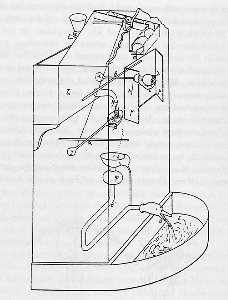 His
most famous inventions include: His
most famous inventions include:
Repeating Crossbow:
Philon's works also contain the oldest known application
of a chain drive in a
repeating crossbow. Two flat-linked chains were
connected to a
windlass, which by winding back and forth would
automatically fire the machine's arrows until its
magazine was empty.
Escapement Mechanism:
(Image, right)
In his Pneumatics (chapter 31) Philon describes
an
escapement mechanism, the earliest known, as part of
a
washstand.
A counterweighted spoon, supplied by a water tank, tips
over in a basin when full releasing a pumice in the
process. Once the spoon has emptied, it is pulled up
again by the counterweight, closing the door on the
pumice by the tightening string. Remarkably, Philon's
comment that "its construction is similar to that of
clocks" indicates that such escapements mechanism were
already integrated in ancient water clocks.
Ctesibius (c. 285 - 222 BC)
Alarm
Clock: The
Hellenistic engineer and inventor
Ctesibius (285�222 BC) fitted his
clepsydras with dial and pointer for indicating the
time, and added elaborate "alarm systems, which could be
made to drop pebbles on a gong, or blow trumpets (by
forcing bell-jars down into water and taking the
compressed air through a beating reed) at pre-set times"
(Vitruv
11.11).
Compressed Air Cannon:
Ctesibius of Alexandria invented a primitive form of
the cannon, operated by compressed air.
|
The Antykithera Mechanism: (c. 150 - 100 BC)
The
Antikythera mechanism is an ancient analogue
computer designed to calculate astronomical
positions. The construction has been dated to the
early 1st century BCE. It is now known to
simultaneously calculate both the Metonic and Saros
cycles through accurate measurements of the sun and
moon. Other planetary inclusions are suspected.
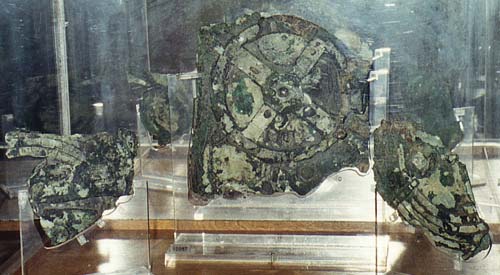
(More
on the Antykithera Device) |
Heron (Hero) from Alexandria (c. 10 - 70AD)
'Michanikos, the Machine man':
Heron was
a Mathematician, Physicist and Engineer who lived c. 10-70 AD. He produced
at least three texts, Pneumatica, Mechanica
and Automata, that testify to the existence of hundreds of
different kinds of machines capable of automated movement. His
descriptions are a clear indication that ancient Greece was
incorporating the idea of automata (mechanical devices) into
their lives.
Works known to be written by Hero:
-
Pneumatica, a description of over 80 mechanical apparatus
working on
air,
steam or
water
pressure, including the hydraulis or
water organ, a
fire extinction apparatus, automata that provide water if a
coin is inserted and the first steam engine (Aeolipile)
amongst others.
-
Automata, a description of machines which
enable wonders in temples (thaumata) by mechanical or pneumatic
means (e.g. automatic opening or closing of temple doors,
statues that pour wine, etc.).
-
Belopoeica,
a collection of war machines. The original manuscript
did nor survive but medieval handwritten copies exist.
-
Mechanica, preserved only in Arabic,
written for
architects, containing means to lift heavy
objects.
The following is a list of
Heron's better known creations:
The
Aeolipile: (Steam turbine - 'Hero Engine'):
Heron described a mechanism that was driven by steam, the
name translates to "the ball of Aeolus"; Aeolus being the
Greek god of the wind. Pre-dating Hero's writings, a device
called an aeolipile was described in the 1st century BC by
Vitruvius in his treatise De architectura; however, it is
unclear whether it is the same device or a predecessor, as
there is no mention of any rotating parts. Typically, and as
Hero described the device, the water is heated in a simple
boiler which forms part of a stand for the rotating vessel.
Where this is the case the boiler is connected to the
rotating chamber by a pair of pipes that also serve as the
pivots for the chamber.
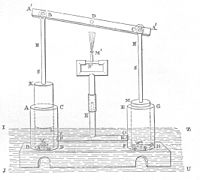
The Water Pump: The first water
pumps were probably designed by
Ctesibius, as Heron frequently
mentions his earlier works in his treatise.
The force pump was later widely used
in the Roman world for fighting fires.
A statue that poured wine: He is said to have made an
automata maid that would fill a cup with a mixture
of wine and water when the vessel was placed in her hand.
When you put an empty
cup to the robot's left hand (normally the left hand was
extended), then it was starting to move down (from the cup's
weight) towards the stable right hand, which was holding a
Oinochoae (a vessel containing wine). When the hand was
reaching at the Oinochoae the automatic machine was able to fill the
cup with the desirable quantity of wine. Next, the robot was pouring
water in the cup mixing it with the wine (the wine in ancient
Greece must have been very strong and therefore it needed
rarefaction).
Wind Operated Pipe Organ:
The
first recorded instance of wind powered machinery. For
instance, his wind-wheel used the energy of
passing gusts of wind to make an organ play.
This didn't require any great technical prowess
like his steam engine or mechanical plays, but
it did apparently require his unique insight -
there aren't any records of wind-powered
machines before Hero came along
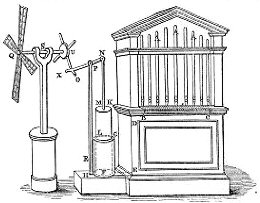 The power supply for the wind-driven organ
relies on the transfer of motion from the
�broad arms like the sails of a wind-mill�
to the piston mechanism. The arms are
attached to one end of a rod, which is
supported such that it turns freely. As the
arms turn in the wind, the rod conveys a
rotary motion to a gear-like pegged disk
fitted tightly on the opposite end. The
revolving pegs make contact with a lever
attached by a pin to the piston rod, causing
the piston to be raised as each peg engages
the rod mechanism. When the peg advances
beyond the lever, the lever is released and
the piston descends in the cylinder. The
falling piston compresses the air, forcing
it out into the base of the cylinder, up
through a connecting tube, and into the box
on which the pipes stand. As the key
mechanism is activated, air is released into
the pipes, causing �the sound of a flute� to
be produced. To assure a steady supply of
air, the windmill
frame can be turned directly into the
prevailing wind.
the
wind-powered organ is the only known
documented windmill type mechanism in
antiquity. Wind power does not reappear in
Western civilization until the twelfth
century. ....from an historical point of
view, these instruments incorporate a manual
keyboard, which as an artifact seems to be
without precedent. Finally, the gear-like
mechanism of the pegged disk attached to the
windmill shaft is designed to transfer power
from the rotating shaft to the reciprocating
piston, thus converting circular to
reciprocal motion. The power supply for the wind-driven organ
relies on the transfer of motion from the
�broad arms like the sails of a wind-mill�
to the piston mechanism. The arms are
attached to one end of a rod, which is
supported such that it turns freely. As the
arms turn in the wind, the rod conveys a
rotary motion to a gear-like pegged disk
fitted tightly on the opposite end. The
revolving pegs make contact with a lever
attached by a pin to the piston rod, causing
the piston to be raised as each peg engages
the rod mechanism. When the peg advances
beyond the lever, the lever is released and
the piston descends in the cylinder. The
falling piston compresses the air, forcing
it out into the base of the cylinder, up
through a connecting tube, and into the box
on which the pipes stand. As the key
mechanism is activated, air is released into
the pipes, causing �the sound of a flute� to
be produced. To assure a steady supply of
air, the windmill
frame can be turned directly into the
prevailing wind.
the
wind-powered organ is the only known
documented windmill type mechanism in
antiquity. Wind power does not reappear in
Western civilization until the twelfth
century. ....from an historical point of
view, these instruments incorporate a manual
keyboard, which as an artifact seems to be
without precedent. Finally, the gear-like
mechanism of the pegged disk attached to the
windmill shaft is designed to transfer power
from the rotating shaft to the reciprocating
piston, thus converting circular to
reciprocal motion.
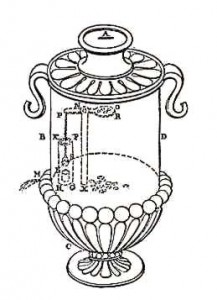
The First Automatic Vending Machine.
When a
coin was introduced through a slot on the top of
the machine, a set amount of holy water was
dispensed. When the coin was deposited, it fell
upon a pan attached to a lever. The lever opened
up a valve which let some water flow out. The
pan continued to tilt with the weight of the
coin until the coin fell off, at which point a
counter-weight would snap the lever back up and
turn off the valve.
A coin is inserted in A and lands on the
receiver R causing it to fall. This action would
raise the other side of the lever P to rise
opening the valve and allowing water to flow out
of the spout M. The coin would slide off of the
receiver and the valve would close.
First Programmable Mechanism:
Sources suggest that Heron
created the first programmable robot as a device to
entertain audiences at the theatre. In about 60 CE, he
constructed a cart with rope wrapped around two independent
axles, with a falling weight to provide power. Using pegs
projecting from the axle, Heron could vary how the rope was
wound around the axle, allowing the robot to change
direction and move along a pre-programmed course. This
primitive mechanism is very similar to a modern binary
computer language; old fashioned punch cards operated on
exactly the same principle. According to accounts, the
device was controlled by a series of ropes with knots tied
in them. As the rope was pulled through the device, the
knots moved levers which caused actions to happen on the
miniature stage. Heron used the same system of ropes,
cylindrical axles and knots to create a mechanical play of
almost 10 minutes in length, including dropping metal balls
onto a sheet of metal to resemble thunder.
Hero's Peri automatopoietikes, demonstrates
that this theatre was actually programmable.
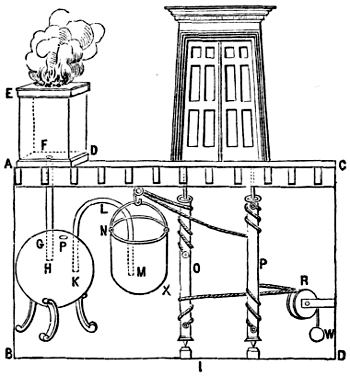
Schematics for automatic doors
to be used in a temple with the aid of steam power.
(2)
Heron designed an automatic temple door opener, which used heat and
pneumatics to open a set of temple doors. To open the doors, the
priest lit a fire on the altar, heating the air within and causing
it to expand. This expansion in volume forced water out of the
sphere and into the bucket, which moved downwards under the extra
weight. This bucket was connected to a rope coiled around a spindle
and, as the bucket moved downwards, this spindle revolved, making
the doors open.
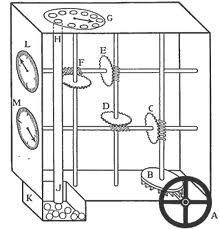
Odometer;
An odometer is a device used for
indicating distance travelled by a vehicle. Vitruvius around 27 and
23 BC describes such a device and Hero also describes an odometer in
chapter 34 of his
Dioptra.
Chariots with wheels of 4 feet diameter turns
exactly 400 times in one Roman mile. For each revolution, a pin on
the axle engage a 400 tooth cogwheel, thus making one complete
revolution per mile. This engages another gear with holes along the
circumference, where pebbles (calculus) are located, that drop one
by one into a box. The number of miles travelled is given simply by
counting the number of pebbles.
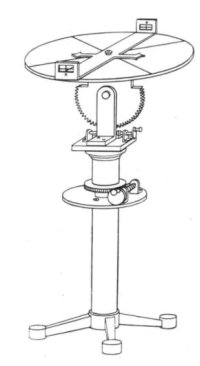
The Bottomless Wine Glass: A goblet is connected to a reservoir
by a tube. As a person drinks wine, the liquid level in the
reservoir falls, releasing a plug coming from a hidden
reservoir. As the liquid levels replenish�perhaps between
gulps�the plug once again stops the hidden reservoir. (2)
The Dioptra: (Image, left) was a practical
invention of Heron that became a foundation of surveying as the
Ancient Greeks built sprawling cites and erected great temples and
monuments. It also became a mainstay of the Greek astronomers,
allowing them to judge the position and elevation of celestial
bodies.
Automata After the Greeks:
Following the
destruction of the Library of Alexander and the collapse of the
Greek Empire, most of the works of the ancient Greeks were lost to
us, and along with it, the art of automata. By the 8th century, the
art made an official recovery in the Middle-east, with the
publication of 'The Book of Ingenious Devices', which
was a large illustrated work on mechanical devices, including
automata, published in 850 by the three Persian brothers known as
the Banu Musa working at the House of Wisdom (Bayt al-Hikma)
in Baghdad, Iraq, under the Abbasid Caliphate.The book described
about one hundred devices and how to use them.
(3)
(Ancient
Greece Homepage)
(Ancient
Science and Technology)
|
 The power supply for the wind-driven organ
relies on the transfer of motion from the
�broad arms like the sails of a wind-mill�
to the piston mechanism. The arms are
attached to one end of a rod, which is
supported such that it turns freely. As the
arms turn in the wind, the rod conveys a
rotary motion to a gear-like pegged disk
fitted tightly on the opposite end. The
revolving pegs make contact with a lever
attached by a pin to the piston rod, causing
the piston to be raised as each peg engages
the rod mechanism. When the peg advances
beyond the lever, the lever is released and
the piston descends in the cylinder. The
falling piston compresses the air, forcing
it out into the base of the cylinder, up
through a connecting tube, and into the box
on which the pipes stand. As the key
mechanism is activated, air is released into
the pipes, causing �the sound of a flute� to
be produced. To assure a steady supply of
air, the windmill
frame can be turned directly into the
prevailing wind.
the
wind-powered organ is the only known
documented windmill type mechanism in
antiquity. Wind power does not reappear in
Western civilization until the twelfth
century. ....from an historical point of
view, these instruments incorporate a manual
keyboard, which as an artifact seems to be
without precedent. Finally, the gear-like
mechanism of the pegged disk attached to the
windmill shaft is designed to transfer power
from the rotating shaft to the reciprocating
piston, thus converting circular to
reciprocal motion.
The power supply for the wind-driven organ
relies on the transfer of motion from the
�broad arms like the sails of a wind-mill�
to the piston mechanism. The arms are
attached to one end of a rod, which is
supported such that it turns freely. As the
arms turn in the wind, the rod conveys a
rotary motion to a gear-like pegged disk
fitted tightly on the opposite end. The
revolving pegs make contact with a lever
attached by a pin to the piston rod, causing
the piston to be raised as each peg engages
the rod mechanism. When the peg advances
beyond the lever, the lever is released and
the piston descends in the cylinder. The
falling piston compresses the air, forcing
it out into the base of the cylinder, up
through a connecting tube, and into the box
on which the pipes stand. As the key
mechanism is activated, air is released into
the pipes, causing �the sound of a flute� to
be produced. To assure a steady supply of
air, the windmill
frame can be turned directly into the
prevailing wind.
the
wind-powered organ is the only known
documented windmill type mechanism in
antiquity. Wind power does not reappear in
Western civilization until the twelfth
century. ....from an historical point of
view, these instruments incorporate a manual
keyboard, which as an artifact seems to be
without precedent. Finally, the gear-like
mechanism of the pegged disk attached to the
windmill shaft is designed to transfer power
from the rotating shaft to the reciprocating
piston, thus converting circular to
reciprocal motion.

 His
most famous inventions include:
His
most famous inventions include:
